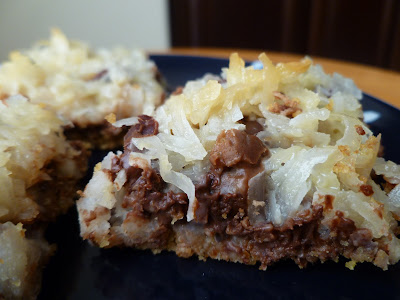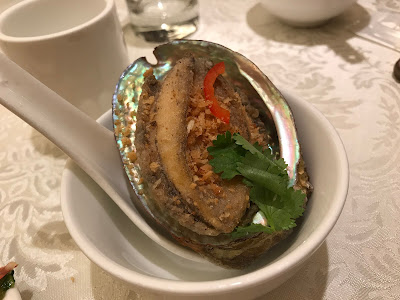Back to the States and back to the recipes. Magic cookie bars could possibly be the most versatile bar
cookies and the easiest ones to make. The basic elements: graham cracker crust,
add-ins, coconut and sweetened condensed milk, are what makes a magic cookie
bar.
But there’s a lot of wiggle room in the “add-ins” part of
the bar. The most common are nuts and chocolate chips of all flavors (milk,
dark, white, butterscotch, peanut butter, cinnamon, etc). This version takes it
a step further and adds a layer of Nutella on top of the graham cracker crust.
The nuts are hazelnuts in keeping with the Nutella theme and I used semisweet
chocolate chips.
To make this easier, I would warm the Nutella very
slightly, just enough so that it flows easily over the graham cracker crust.
The crust isn’t very thick and it’s easy for the graham cracker crumbs to
separate and lift off the rest of their brethren valiantly holding the crust
together in order to stick to the Nutella if the Nutella is too firm. Microwave
the Nutella so it’s more liquid and spreads more easily over the crust.
This version has you putting all the add-ins before
laying the coconut over everything then pouring the sweetened condensed milk
over it all. That makes for a plain landscape, if you will, since everything is
hidden underneath the blanket of coconut. If you want things to look a bit more
lively, reserve some of the chopped hazelnuts and chocolate chips to sprinkle
over the coconut before you pour the sweetened condensed milk over it all.
This was a good magic cookie bar. Then again, I haven’t
met a magic cookie bar I didn’t like. Feel free to get creative. Use more
Nutella than the recipe calls for if you’re a Nutella freak; fly that flag! Be
generous with the chopped hazelnuts (toast them first to get the best flavor)
and the chocolate chips. Spread the coconut with a lavish hand. There’s no
wrong way to make this.
1 1/2 cups graham cracker crumbs1/2 cup melted butter
1/2 cup Nutella or more if desired
1/2 cup toasted hazelnuts, chopped
3/4 cup chocolate chips
1 cup toffee bits
1 cup coconut, flaked or shredded
1 14-ounce can sweetened condensed milk
- Preheat oven to 350 degrees F. Line a 9 x 13 pan with foil and lightly spray with nonstick cooking spray.
- In a large bowl, combine graham cracker crumbs and melted butter, mixing until combined. Press into an even layer in the bottom of prepared baking pan.
- Spread nutella evenly over crust. Layer on the chopped hazelnuts, chocolate chips and toffee bits.
- Cover with a layer of coconut then evenly pour the sweetened condensed milk over entire pan.
- Bake for 25-30 minutes or until top is slightly golden brown. Cool completely before cutting.




















































